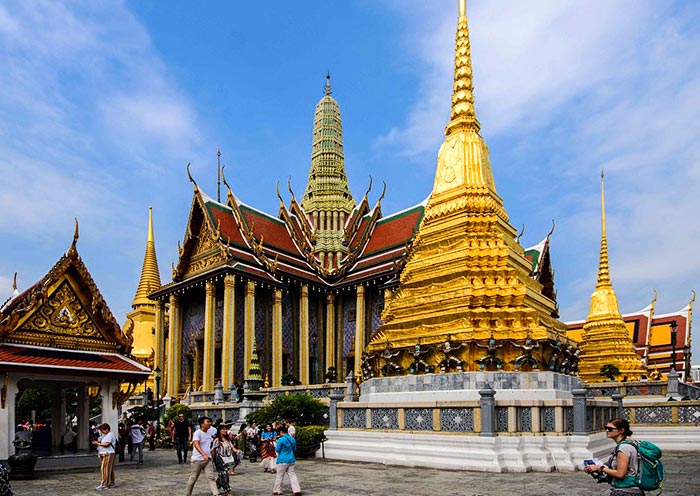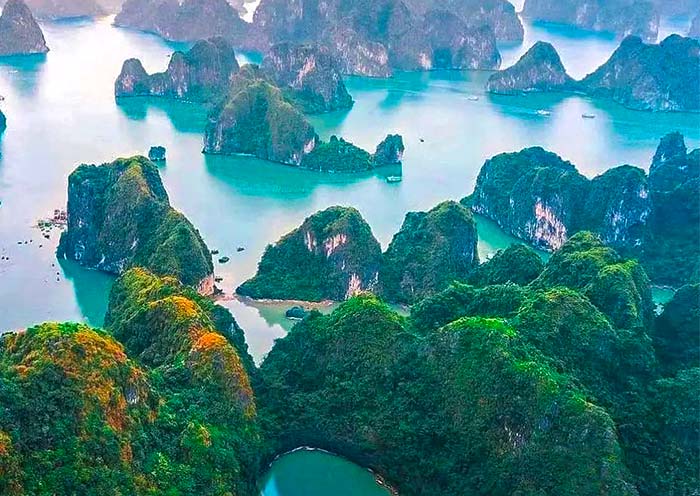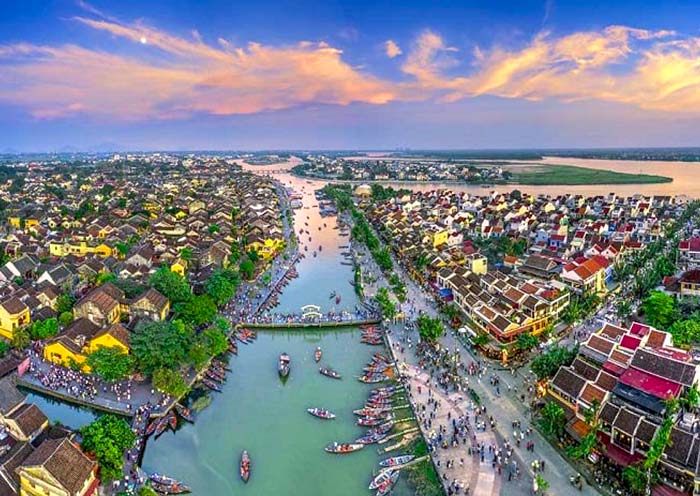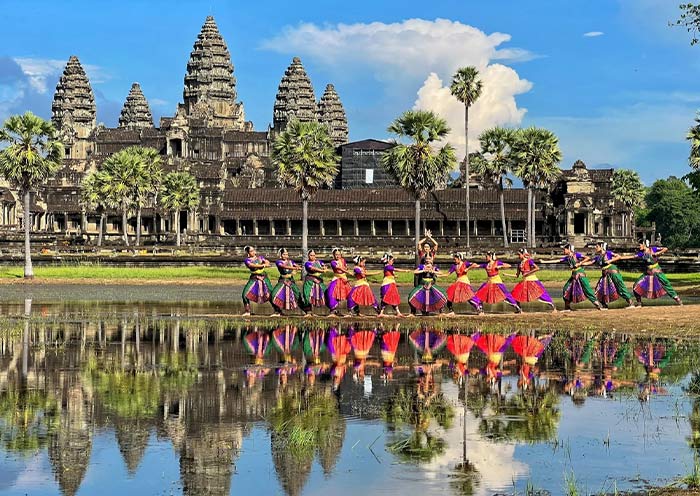We traveled with 7 lady friends. Our trip with Asia Odyssey Travel was so well planned, and seamless. Our time in Bhutan was exceptional, being led by Ugyan and Doji. What two very wonderful men. They were both so very knowledgeable, kind, and helpful. I cannot say enough good about our time in Bhutan with these two good men,...our guide and driver. Thank you Asia OdysseyTravel!!! p.s. Our trip was planned by Tony of Asia Odyssey. He was amazingly helpful, and planned our trip flawlessly! Thank you, Tony!
12 Days Cambodia Thailand Culture Tour: Southeast Asia’s Cultural Wonders
- Highlights
- Itinerary
- Price
- Trip Notes
- Accommodation
- Photos
- Reviews
A Cultural and Temple Enthusiast's Dream Journey
This 12-day tour across Cambodia and Thailand is perfect for cultural enthusiasts and temple lovers. It delves into the rich heritage and mystical temples of these fascinating countries, combining awe-inspiring historical sites with unforgettable local experiences. From the iconic spires of Angkor Wat to the serene beaches of Phuket, and from the bustling markets of Bangkok to the ancient ruins of Chiang Mai and the artistic spirit of Chiang Rai, each day offers captivating moments that enrich your understanding of Southeast Asian culture.
In Siem Reap, explore the world's largest religious monument, the Angkor Wat Complex. In Bangkok, delve into the city's royal history and Buddhist culture. Discover the traditional Thai way of life at the Damnoen Saduak floating markets and the intriguing Maeklong Railway Market.
In Chiang Rai, marvel at the contemporary artistry of Wat Rong Khun (the White Temple). Visit the Golden Triangle to see where Thailand, Myanmar, and Laos meet. Learn about the history of opium and experience the unique culture of the Long Neck Karen village. In Chiang Mai, immerse yourself in the history of the Lanna Kingdom. Explore the old city, visit significant temples, and observe elephants at the Elephant Jungle Sanctuary. Conclude your journey in Phuket, where you can relax and reflect on the beautiful beaches.
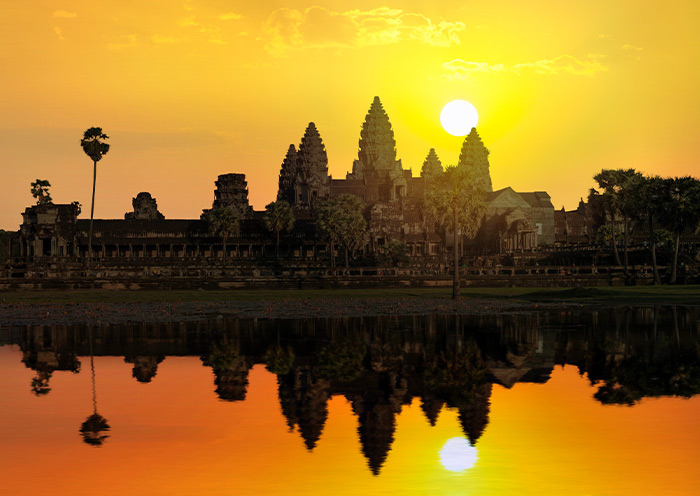
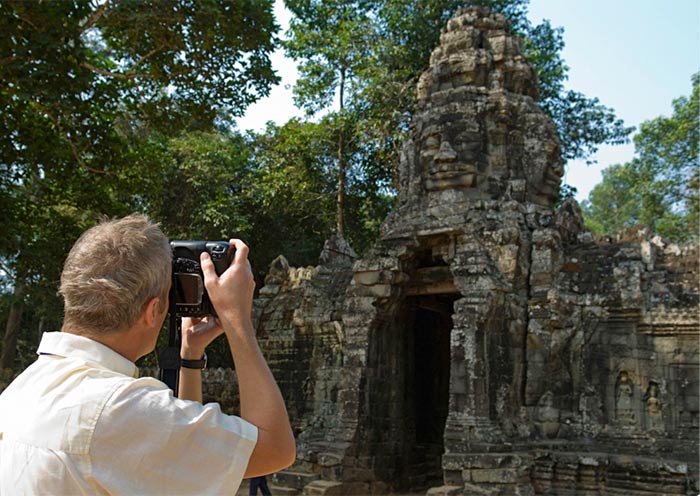
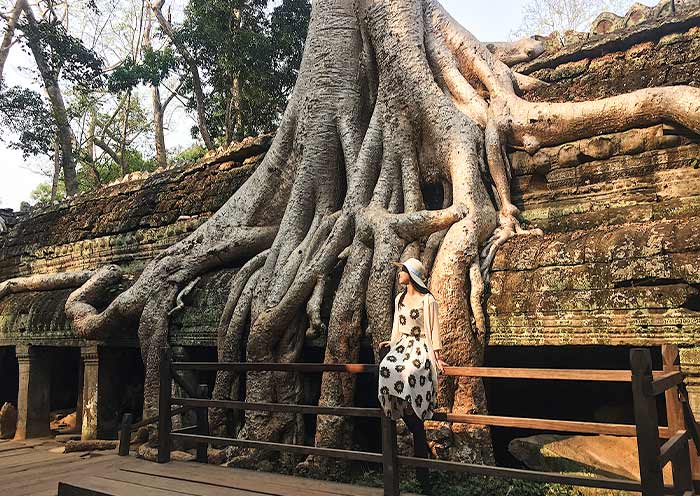
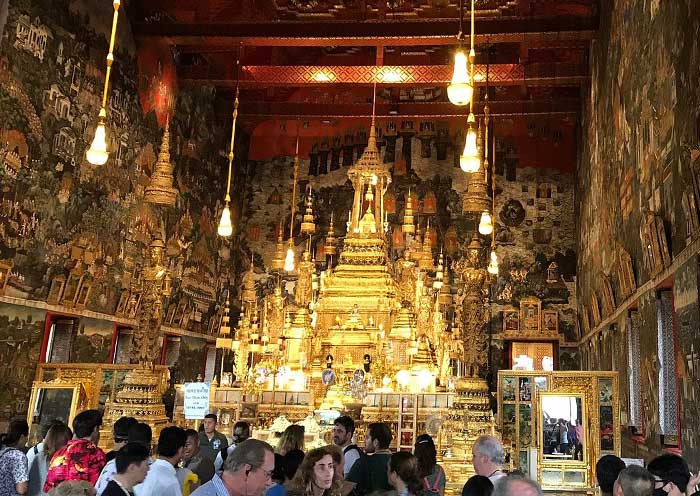
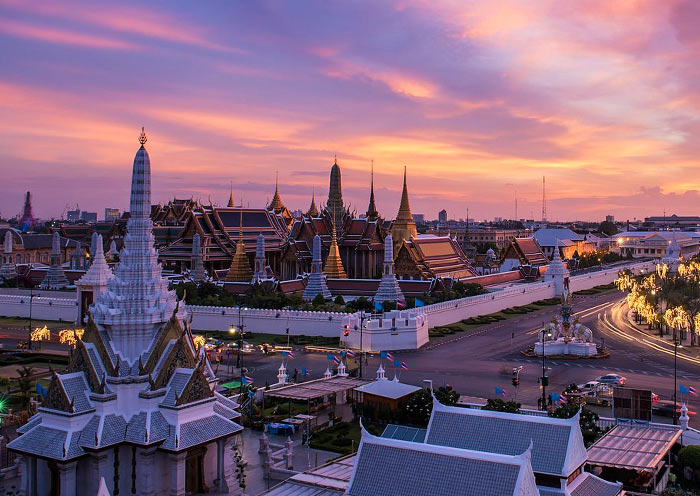


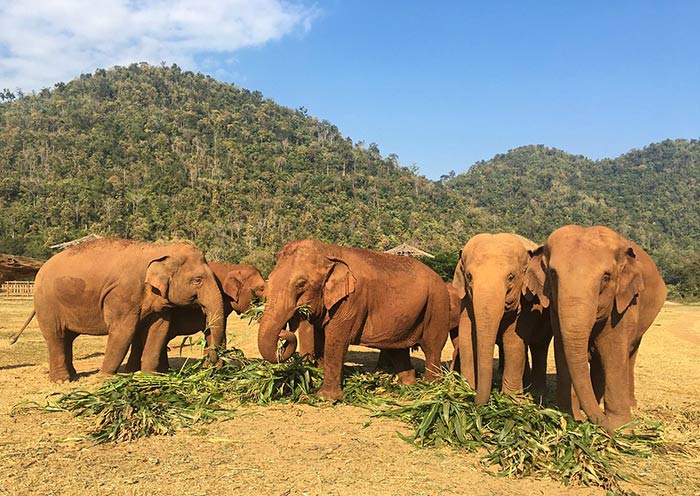

Itinerary at a Glance
Siem Reap (2 Days)
Floating Village, Tonle Sap Lake, Angkor Complex: Angkor Wat & Sunrise, Ta Prohm, Angkor Thom, Phnom Bakheng & Sunset
Bangkok (3 Days)
Wat Phra Kaew, Grand Palace, Wat Pho, Chinatown, Wat Arun, Damnoen Saduak Floating Market, Maeklong Railway Market
Chiang Rai (2 Days)
Mae Kachan Hot Spring, White Temple, The Golden Triangle, Hall of Opium, Long Neck Karen village, Wat Huay Pla Kung
Chiang Mai (2 Days)
Elephant Jungle Sanctuary, Chiang Mai Cooking Class (Optional), Chiang Mai Old City, Tha Phae Gate, Wat Phra Singh, Wat Chedi Luang
Phuket (3 Days)
Phuket Free Tour: Phuket Old Town Tour (Optional 1), Day Trip to Phi Phi Island (Optional 2); Day Trip to the James Bond lsland (Optional 3), Elephant Sanctuary (Optional 4)
Itinerary Day by Day
Welcome to Siem Reap, your gateway for the Temples of Angkor. When you arrive at Siem Reap–Angkor International Airport (SAI), your tour guide and driver will meet you at the exit and then escort you to the hotel in downtown Siem Reap.
Siem Reap is a city in northwestern Cambodia, best known as the gateway to the Temples of Angkor, including the iconic Angkor Wat, which is just 6 kilometers away. The city has transformed into a major tourist hub, with a diverse range of accommodations, and bustling nightlife with numerous restaurants, bars, and night markets.
In the afternoon, you will travel to Tonle Sap Lake to visit the floating village of Kompong Khleang. Known as the largest freshwater lake in Southeast Asia, Tonle Sap is home to numerous floating villages. These are unique for their stilted houses, which are built on platforms supported by wooden poles or tethered to boats, adjusting to the lake's changing water levels. The villages also have floating schools, shops, and even churches.
Enjoy a boat ride (about 1.5 hours) to observe the residents' unique lifestyle and the region's rich biodiversity. If it happens to be dusk, you will appreciate the beautiful sunset on Tonle Sap Lake.
In the evening, you will enjoy a sumptuous welcome dinner buffet. While dining, you'll be treated to a captivating Khmer traditional dance performance, featuring elegant movements and vibrant costumes set to melodious traditional music.
Arrival Ideas:
Siem Reap Airport: Siem Reap-Angkor International Airport (REP) is the main airport in Siem Reap, located about 45 kilometers from downtown and approximately 50 kilometers from the Temples of Angkor.
Flights to Siem Reap: For internal flights, the most common routes are from Phnom Penh, the capital of Cambodia, and occasionally from Sihanoukville, especially during the tourist season. For international flights, it is well connected with major cities in Asia, making it relatively easy to find direct flights from places like Bangkok, Kuala Lumpur, Singapore, Ho Chi Minh City, and various cities in China.

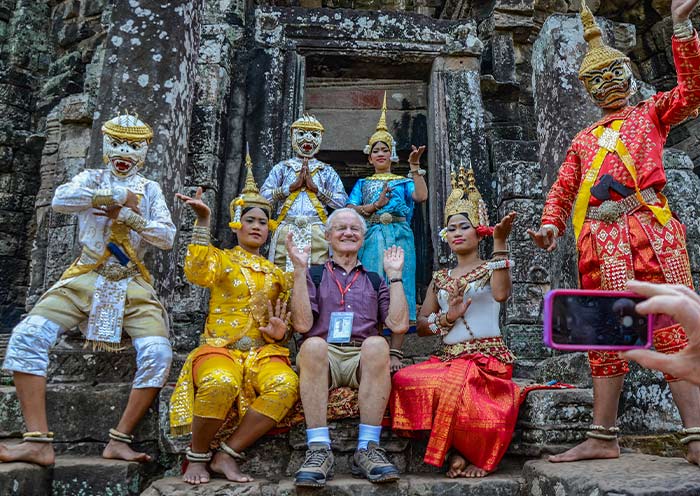
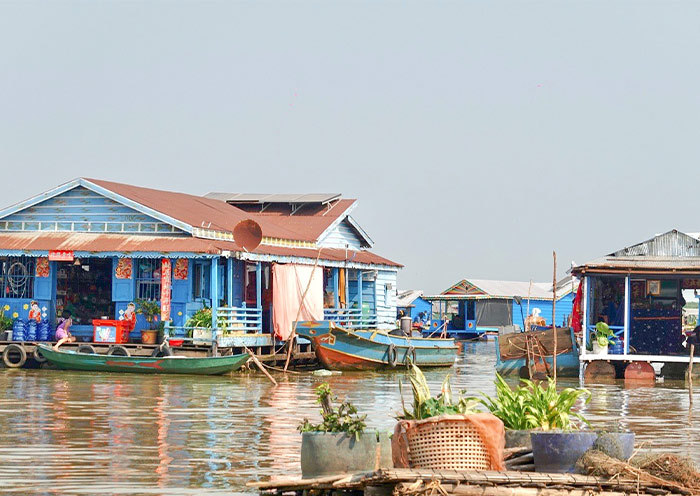
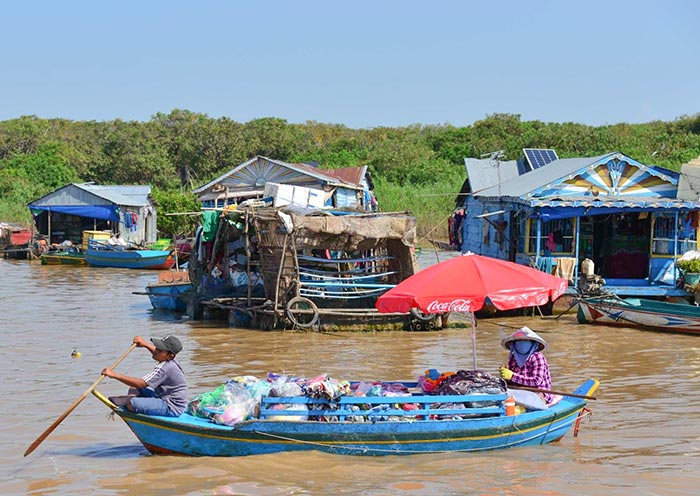
Designated as a UNESCO World Heritage site, Angkor Archaeological Park is a vast and impressive complex. It spans an area of roughly 400 square kilometers and contains the magnificent remains of the various capitals of the Khmer Empire, which flourished from the 9th to the 15th centuries.
Today, we will guide you through an exploration of some of the most iconic temples and structures within the park, including the majestic Angkor Wat and Angkor Thom complexes, and the enchanting Ta Prohm.
Scenic Spots You will Pass:
Sunrise → Angkor Thom → Ta Prohm → Angkor Wat → Phnom Bakheng Sunset → Get back to your Hotel
Start your day early with a sunrise viewing at Angkor Wat. Arrive at Angkor Wat in time to find a good spot to watch the sunrise. Tips: The sun rises between 5:30 AM and 6:30 AM, depending on the time of year. The silhouette of Angkor Wat’s iconic spires stands sharply against the lightening backdrop, creating a stunning contrast that slowly fills with color. The temple's vast moat reflects this magical scene, doubling the beauty in a perfect mirror image that enhances the surreal atmosphere. After the sunrise, head back to your hotel for breakfast and a short rest.
After breakfast, head to Angkor Thom, the last and most enduring capital city of the Khmer empire. It was established in the late 12th century by King Jayavarman VII in the late twelfth century. Angkor Thom means "Great City" in Khmer. Set over 10 square kilometers, the aptly named last great capital of the Khmer empire took monumental to a whole new level.
Enter through the South Gate and proceed to the Bayon Temple at the city's center. This temple is known for its numerous smiling faces carved into its towers. Each of its 54 Gothic towers is decorated with 216 gargantuan smiling faces of Avalokiteshvara. The temple also features 1.2km of extraordinary bas-reliefs, incorporating more than 11,000 figures. Take your time to marvel at these detailed bas-reliefs, which portray historical events and scenes from daily life in the empire. A short walk northwest from the Bayon will bring you to the Baphuon Temple. This temple, which predates Angkor Thom, was originally a Hindu temple dedicated to Shiva.
Next, visit the Terrace of the Elephants. King Jayavarman VII used this terrace as a viewing platform to observe his victorious returning army. You'll find it adorned with carvings of elephants and other animals, providing excellent photo opportunities. Continue to the nearby Terrace of the Leper King. This 7-meter high laterite platform features multiple tiers of meticulously carved walls depicting nagas (serpents), demons, and various mythical beings. Conclude your visit to Angkor Thom by exiting through the Victory Gate on the east side of the city.
Later, proceed to Ta Prohm (Jungle Temple). Its appeal lies in the fact that, unlike the other monuments of Angkor, it has been swallowed by the jungle, and looks very much the way most of the monuments of Angkor appeared when European explorers first stumbled upon them. It was also featured in the movies "Tomb Raider" and “Raiders of the Lost Ark”, which adds to its popularity. After exploring Ta Prohm, enjoy a relaxing lunch at one of the local restaurants nearby.
In the afternoon, return to Angkor Wat for a more detailed tour of this iconic temple. Uniquely designed with a westward orientation, Angkor Wat is best viewed in the afternoon light. Angkor Wat, the largest monument of the Angkor group and the best preserved, is an architectural masterpiece. Its perfection in composition, balance, proportions, relief, and sculpture make it one of the finest monuments in the world.
Angkor Wat is surrounded by a vast moat, 190 meters wide, forming a rectangle of 1.5 by 1.3 kilometers, which symbolizes the mythical oceans surrounding Mount Meru, the center of the universe in Hindu cosmology. Visitors can enter through the west-facing main gate, which leads directly into a long causeway lined with naga balustrades. Spend time in the galleries which feature extensive bas-reliefs depicting epic stories such as the Battle of Kurukshetra from the Mahabharata, the Judgment by Yama, the Hindu god of death, and scenes of heavenly nymphs (Apsaras) and everyday life in the Khmer Empire. At the heart of the temple complex is the central sanctuary surrounded by four smaller towers, forming a quincunx. The central sanctuary, rising majestically above the forested landscape, symbolizes the mythical Mount Meru and offers a unique perspective on the temple’s layout and the geometric precision with which it was built. Climb up to the central tower, a privilege that offers not only a closer view of the intricate lintel carvings and sculpted friezes but also panoramic views of the entire complex and its surroundings.
If you have enough energy, consider climbing up to Phnom Bakheng Hill to enjoy the sunset view. The climb takes about 15-20 minutes. Arrive early as this popular spot can get crowded at sunset. From here, watch the sky change colors over the main temples of Angkor and the surrounding forests - a perfect end to a day of exploration.
After the tour, drive back to your hotel. Stay overnight in Siem Reap.

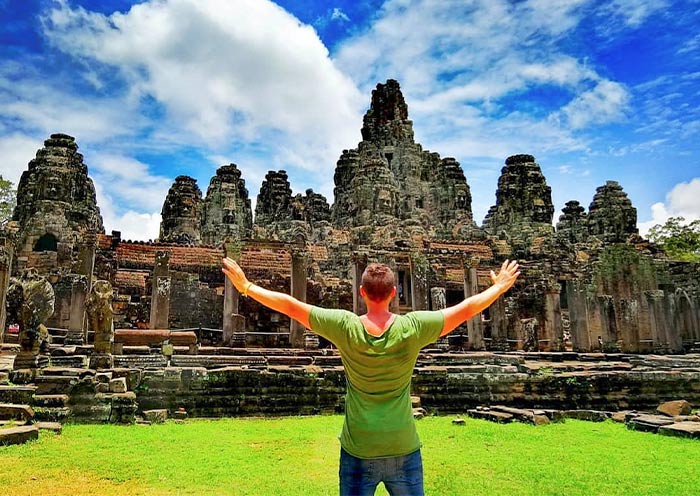
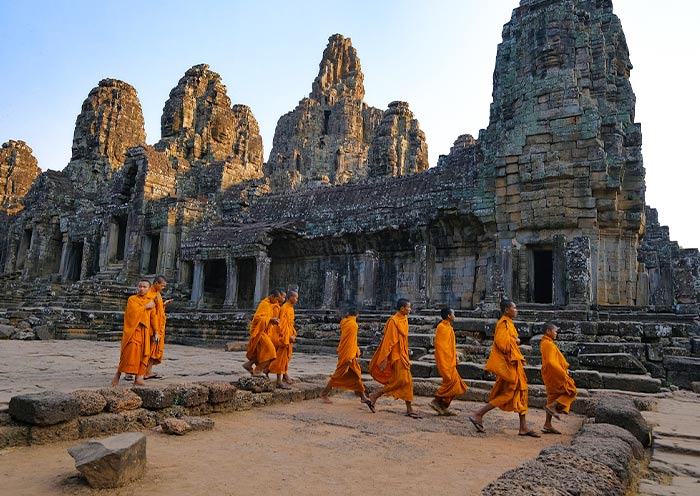
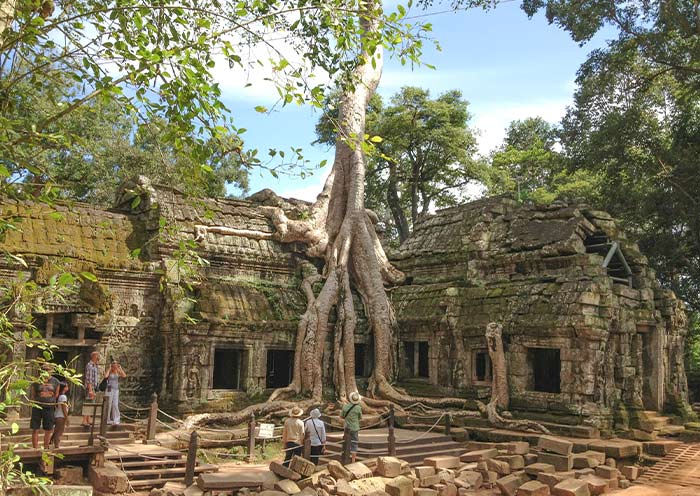
Then, you'll driven to Siem Reap–Angkor International Airport for your flight to Bangkok, Thailand. The drive takes approximately an hour.
Welcome to Bangkok, the capital city of Thailand! Upon your arrival at the airport in Bangkok, the tour guide and driver will meet you at the exit and then escort you to the hotel in downtown Bangkok. You can have a good rest in your hotel and get ready to explore Bangkok with your guide the next day.
Bangkok means the "City of Angels" in translation from its ceremonial Thai name, Krung Thep Maha Nakhon. It is a vibrant metropolis known for its bustling markets, ornate temples, and delicious Thailand street food. You can indulge in Bangkok's diverse culinary scene, from street eats to upscale dining. Shop till you drop in luxury malls or explore local markets. Enjoy the city's lively nightlife, rooftop bars, and live music venues. Bangkok offers a blend of tradition and modernity, making it an exciting and captivating destination.

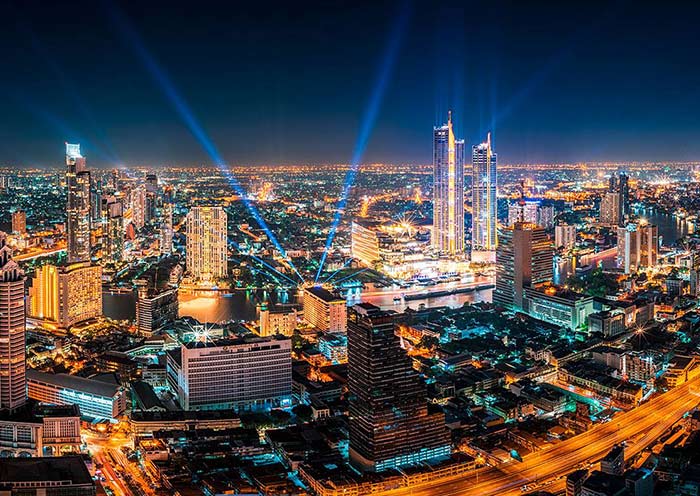
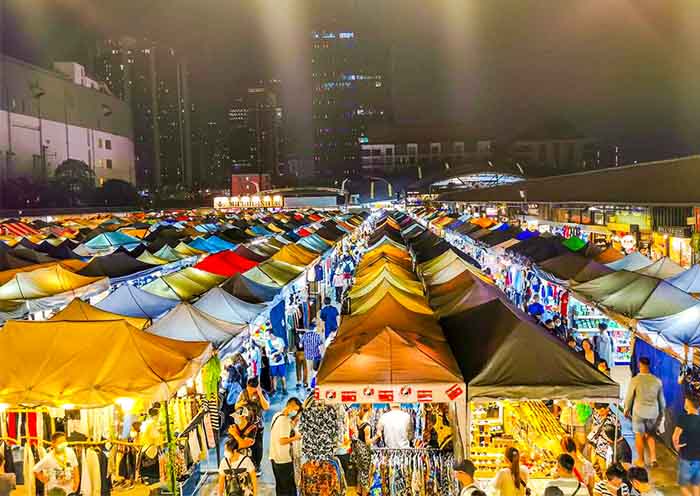

Today, you will explore the Top 5 must-visit places in Bangkok: Wat Phra Kaew, Grand Palace, Wat Pho, Wat Arun, and Chinatown. You see “Wat” means “Temple” in Thai language. You will also experience a Thai tuk-tuk, take a ferry or boat ride on the Chao Phraya River, and indulge in local food in Chinatown. This is a classic Bangkok trip, allowing you to witness 2 of the three treasures of Thailand: the jade Buddha and the reclining Buddha.
In the morning, head to Wat Phra Kaew which was built in 1782 and is located in the northeast corner of the Grand Palace in Bangkok. Covering one-fourth of the Grand Palace's area, Wat Phra Kaew is the most famous royal Buddhist temple in Thailand. This temple is renowned for enshrining one of three national treasures of Thailand, the Emerald Buddha, which is carved from a single block of Emerald. Each year, the Thailand King personally changes the Buddha's robes according to Thailand's three unique seasons. Each season changes with a certain robe: a gold robe embedded with rubies for the hot season, a gold robe embedded with sapphires for the rainy season, and a pure gold robe for the cool season. Don’t forget to check which robe the Emerald Buddha wears when you are there.
On the walls surrounding the cloisters of Wat Phra Kaew, there are a total of 178 murals (1,000m in length). Painted during the reign of King Rama I, the first monarch of the Chakri Dynasty in 18th-century Thailand (Bangkok Dynasty), the murals depict scenes from the Indian mythological epic "Ramayana," which narrates the story of King Rama joining forces with the monkey deity Hanuman to defeat the demon king Ravana and rescue the exquisite princess Sita. It is said that the story of the "Journey to the West" is also based on this legend. All the murals were created by royal court painters and the golden pigments used were made entirely from gold, resulting in exquisite and unparalleled artwork.
With the guidance of your tour guide, you can learn about the mythical creatures within Thai Buddhist architecture. For example, there is the Garuda, a mythical bird and guardian deity of Buddhism, perched on the rooftops. At the entrance of the temple, you'll find Yaksa, a protective deity, and outside the halls, there are statues of Kinaree, a mythical half-bird, half-human creature. The base of the pagoda is adorned with statues of Hanuman, the monkey deity.
After visiting Wat Phra Kaew, you can go on a visit around the Grand Palace. The Grand Palace, which was first established in 1782, was constructed as a replica of the old palace in the former capital city of Ayutthaya. It serves as a symbol of the Bangkok Dynasty and is the most well-preserved, largest, and most distinctive palace in Thailand. The Grand Palace is currently used for coronation ceremonies, royal celebrations, and hosting foreign dignitaries. From King Rama I to King Rama VIII, all the monarchs of the Bangkok Dynasty resided in the Grand Palace. However, after an assassination incident in 1946 involving King Rama VIII, King Rama IX moved to a new residence. The Bangkok Dynasty has continued to the present day, with the current monarch being King Rama X.
The Grand Palace complex consists of 22 buildings and is elegantly situated along the banks of the Chao Phraya River. The main structures are four distinct palaces (Borombhiman Hall, Amarindra Hall, Chakri Mahaprasat, Dusit Hall), showcasing the essence of Thai architecture, painting, sculpture, and interior decoration. It is often referred to as the "Encyclopedia of Thai Art". By the way, the Thai King is considered the incarnation of the god Vishnu, and Garuda is Vishnu's guardian. As a result, sculptures of the Garuda (stepping on 2 serpents) can be found on door lintels, eaves, and walls, with a total count exceeding several hundred. Witnessing the changing of the guards' ceremony is a bonus when visiting the Grand Palace.
Then, visit Wat Pho (Temple of the Reclining Buddha) which is a 10-minute walk from the Grand Palace. As the oldest and largest temple in Bangkok, Wat Pho houses the largest reclining Buddha and the highest number of Buddha images and stupas in the city. The reclining Buddha, one of three national treasures of Thailand, is 46 meters tall and 108 meters long, depicting the scene of the Nirvana of Gautama Buddha. Within the temple grounds, there is a Bodhi tree, believed to be the spot where the Buddha meditated. The temple is adorned with about 100 stupas, with the most magnificent being the four stupas which are decorated with blue, white, yellow, and green ceramic tiles. In the courtyard, you can also see many Chinese-style stone sculptures, such as door guardians and lions, which were traditionally used on ships for ballast and protection against evil spirits.
Wat Pho is regarded as Thailand's first university and is considered the birthplace of Thai medicine and traditional Thai massage. It still houses a private school established in 1957 that teaches traditional Thai medicine and offers authentic Thai massages (optional, self-pay).
In the afternoon, take a ferry or boat (cruise; optional) on the Chao Phraya River to view Wat Arun (outside view). The Chao Phraya River divides Bangkok into two parts, and many famous temples are concentrated along its banks. The Wat Arun, is one of the most prominent temples that stands on the river's edge, complementing the Grand Palace on the opposite side. (Note: Due to the hot weather and the presence of numerous steps at Wat Arun, many of our guests opt to take a boat trip and enjoy the view of Wat Arun from the outside, either from the boat itself or from the opposite side.)
Built in 1809, Wat Arun was established to honor King Taksin (郑信), the 41st monarch of Thailand (1767-1782) and a national hero. During the invasion of the Burmese army, King Taksin led the Thai people in a brave resistance, successfully driving out the Burmese and establishing the Thonburi Kingdom. To commemorate this Chinese-Thai king (from Guangdong), the temple was named Wat Arun, meaning "Temple of Dawn", as the battle took place at dawn. The main stupa of the temple stands at a height of 79 meters and is often referred to as the Thai version of the Eiffel Tower. In contrast to many other magnificent temples adorned with gold, Wat Arun stands out with its elegant white structure, attracting numerous visitors who come to rent traditional Thai costumes for photography. Situated by the Chao Phraya River, Wat Arun (Temple of Dawn) also offers a captivating view of the sunset, which is another reason why people flock to this location.
In the evening, take a Thai tuk-tuk to Chinatown Bangkok for dinner. Chinatown Bangkok (Yaowarat) is renowned as one of Bangkok's liveliest and most bustling commercial areas, with reportedly 70% of the city's gold shops located in Chinatown. The entire street of Chinatown stretches for about 2 km, lined with numerous shops, and thousands of businesses proudly displaying eye-catching Chinese signs. You may have watched the film Detective Chinatown, which was filmed in Chinatown Bangkok which has a history of over 200 years. You can search for the hidden shops that appeared in the film while enjoying the food in Chinatown, a haven for foodies. The restaurants and food stalls here provide a rich selection of Chinese, Thai, and other Asian delicacies. From classic pad thai to exotic grilled meats, there's something for everyone.
Warm Tips:
1. When entering the Grand Palace or temples, it is prohibited to wear shorts or skirts that do not cover the knees. Shoulders and midriffs should be covered, and clothing should not be excessively tight or have holes.
2.Upon entering a temple, remove your hat and shoes. Photography is prohibited inside the temple halls. The use of drones is strictly prohibited within the royal grounds.
3. Do not enter unauthorized areas or areas marked with warning signs. Unauthorized photography or videography is prohibited in restricted areas.
4. The lights of Wat Arun usually turn on around 7 PM. For sunset, it is recommended to arrive Wat Arun around 5:30 PM, do double check with your guide for the sunset time based on your travel schedule. It is said that the best spot to capture the beauty of Wat Arun is in the alley across from Wat Pho, where a restaurant is located.
5. Opening Hours for Temples (Wat):
Wat Phra Kaew : 8:30 AM - 3:30 PM
Wat Pho: 8:00 AM - 6:30 PM
Wat Arun : 8:00 AM - 6:00 PM




Today, you will depart Bangkok to Samut Songkhram (80 km,1.5h) early (about 7am), to explore the floating & Train Markets and unveil the Thai countryside life.
The best and most lively time to visit Damnoen Saduak Floating Market is in the morning (7am - 14 pm). As the largest and most well-known floating market among Thai and foreign tourists, this water market has a history of over a 100 years, offering a glimpse into a traditional way of local life. Enjoy your time watching vendors sell fresh products (fruits, vegetables, flowers), local handicrafts, souvenirs (locally-made bags), and delicious Thai street food from boats on canals. Be sure to try some local snacks such as coconut ice cream, coconut pancakes, pad thai, boat noodles, mango sticky rice, fresh spring rolls. It's photographers' heaven to capture a scene often depicted in movies (Detective Chinatown) and postcards. Take a long-tailed speedboat or a more relaxed paddle boat ride (optional and recommended) through the canals, immerse yourself in the bustling trading boats, experience the joy of shopping on the boat, and navigate through the traditional buildings of Siam people, as if traveling through time, which is enchanting. It is the only market still preserves the traditional Thai water market style today! If you prefer not to take a boat, you can also explore the market under the sheltered walkways on land.
Warm Tips for Damnoen Saduak Floating Market:
1. The market can get crowded, so it's recommended to wear your backpack in front to prevent theft.
2. Be cautious not to drop your belongings into the river.
After visiting Damnoen Saduak, you will head to Maeklong Railway Market (20km, 0.5h) which is famous as the most dangerous market in the world. This is a railway market with a history of over 100 years. The stalls, filled with vegetables and meat, are set up right beside the train tracks. When the train whistle sounds and the train approaches, the vendors swiftly fold their stalls within 10 seconds. The train then passes by closely, allowing you to greet the passengers onboard with joy. You will see tourists rushing around to find the best spot for photos, while the nearby vendors continuously remind you of the best places to stand. It's a moment filled with excitement and happiness. Once the train has passed, the train market’s stalls return to their original state.
Warm tips for Maeklong Railway Market:
1. It's advisable to check the train arrival times in advance to avoid missing them.
2. Train arrival times: 8:30 AM, 11:10 AM, 2:30 PM, 5:40 PM3.
3. Train departure times: 6:20 AM, 9:00 AM, 11:30 AM, 3:30 PM4.
4. According to the above schedule, wait at the stalls beside the railway tracks 5 minutes before the designated train time.
5. It is livelier on weekends, with a greater number of stalls.
Head back to Bangkok and have a good rest at your hotel. If you like you can enjoy your free time by visiting Khao San Road for the night markets that offer a dazzling array of street food, souvenirs, and clothing.




This morning,you will have some free time in Bangkok and explore more on your own till your guide or driver escorts you to the airport for your flight to Chiang Rai.
If you like you can take a morning tuk-tuk ride to visit Pak Khlong Talat Flower Market (optional), also known as Bangkok Flower Market, which is one of the top 9 flower markets in the world. This Flower Market is a must-visit destination for a sensory feast. This vibrant market immerses you in a kaleidoscope of colors and fragrances, offering an unforgettable experience. Beyond flowers, the market offers glimpses of local life, with lively activity and bustling vendors. Open 24/7, it accommodates all schedules, allowing early risers and night owls to indulge in its charm. Capture unique photos amidst the vibrant displays, and explore stalls selling fruits, vegetables, and floral supplies.
Then, head to airport for your flight to Chiang Rai (1h25m). In the afternoon, you will visit Wat Rong Khun, the White Temple. Designed by the Thai artist Chalermchai Kositpipat, this stunning temple is a unique work of art that combines traditional Buddhist elements with contemporary themes. It is an amazing project reflecting the artist's personal beliefs and philosophies. On-site, there is a small museum where you can learn more about the artist's vision for the temple.
The most striking feature of Wat Rong Khun is its dazzling white exterior. Adorned with millions of tiny mosaic glass pieces, it glistens in the sunlight, creating a truly magnificent sight. To enter the temple grounds, you must cross a bridge lined with outstretched hands (Hands Reaching from Hell), symbolizing the cycle of rebirth (Bridge of Crossing Over to Nirvana) according to Buddhist teachings. Inside, you can admire exquisite murals portraying scenes from Buddhist mythology. And don't forget to visit the Golden Restroom, a shimmering building that provides a striking contrast to the white temple itself.
After that head to your hotel at Chiang Rai and have a good rest. If time permit, you can explore freely around Chiang Rai.
Free time ideas:
1.Baan Dam Museum (Black House Museum): It offers a unique experience with unconventional art by Thawan Duchanee. It features thought-provoking exhibits(made from animal skins, bones, and skulls) that challenge beauty and comfort, exploring themes of mortality and human suffering.
2.Wat Rong Suea Ten (Blue Temple): It offers a beautiful and serene escape compared to its more famous neighbors, the White Temple and Black House. Its cobalt blue exterior symbolizes purity and wisdom.
3.Night Bazaar: The Chiang Rai Night Bazaar is a must-visit for anyone seeking a taste of local culture, delicious food, and a fun shopping experience.
Opening Hours for Temples (Wat):
1.Wat Rong Khun (White Temple, 8 AM–5 PM)
2.Baan Dam Museum (Black House Museum; 9 AM–5 PM)
3.Wat Rong Suea Ten (Blue Temple, 7 AM–8 PM)
4.Do double-check with your local guide for the opening time.


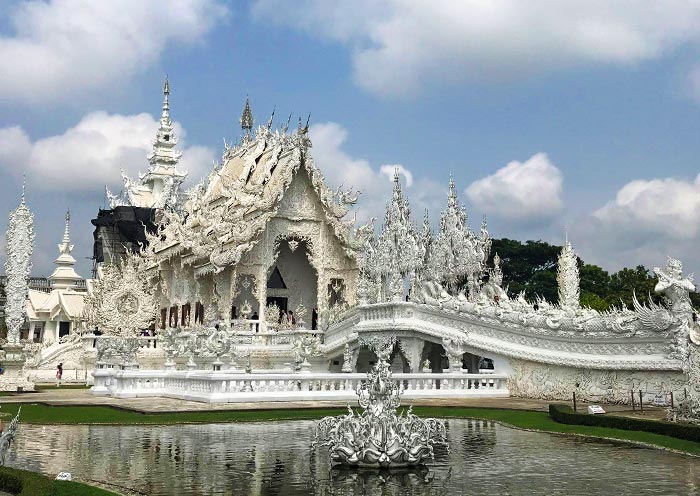

This morning, drive to the Golden Triangle region 70km (1.5h) where the borders of Thailand, Laos, and Myanmar meet. The trip to Chiang Rai is incomplete without a visit to the Golden Triangle. It is where the Ruak River flows into the Mekong River and the three countries come together. It was once notorious for opium production, but today it's a popular tourist destination known for its stunning scenery, hill tribes, and cultural experiences.
You will visit the Hall of Opium which tells the story of opium production in the Golden Triangle, from its history and cultivation to its impact on the region. Explore exhibits that delve into the history of opium cultivation, trade, and use in the region. You'll learn about the opium poppy plant, its origins, and how it spread throughout Southeast Asia, particularly in the Golden Triangle. The museum explores the involvement of various hill tribes in the Golden Triangle in opium cultivation and trade. You'll gain insights into their way of life and the economic realities they faced.
In the afternoon, head back to Chiang Rai via a visit to Long Neck Karen village and learn more about Hill Tribe Life. The Kayan people (also called Long Neck Karen) have a distinct cultural tradition of neckrings worn by women. Visiting a village and purchasing handicrafts directly supports the Karen people economically. You might have the opportunity to observe villagers going about their daily routines, offering a glimpse into their traditional way of life, such as weaving or farming.
At last, pay a visit to Wat Huay Pla Kung for Sunset. Wat Huay Pla Kung, also known as the Dragon Temple or the Big Buddha Temple, offers a unique and visually striking experience for visitors to Chiang Rai. You will marvel at the Chinese-Lanna Fusion Architecture. Unlike most Thai temples adorned in gold, Wat Huay Pla Kung stands out with its predominantly white walls and vibrant colors. This unique style blends traditional Lanna architecture with strong Chinese influences, particularly evident in the use of red, yellow, and green hues. Be sure to admire the intricate details on the facade and throughout the temple complex.
As the sunlight softens, the intricate details and ornamentation on the temple's exterior become even more prominent. The temple complex sits on a hill offering panoramic views of the surrounding landscape. Witnessing the sunset paint the sky with vibrant colors while overlooking the scenery adds another layer of beauty to the experience. After sunset, the nine-story pagoda is illuminated, creating a majestic sight against the darkened sky. The soft glow highlights the unique architectural details, making it a captivating sight.
Back to your hotel in Chiang Rai and have a good rest.

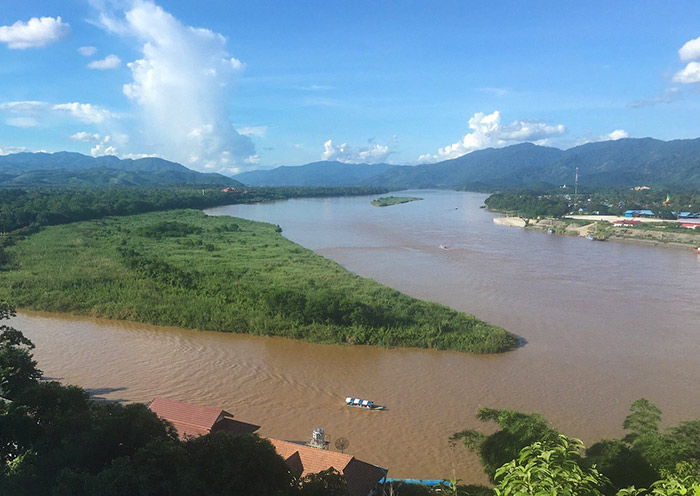


Today, head to Chiang Mai (190km,3h15m) via a quick stop at Mae Kachan Hot Spring. Then, enjoy a Half day Citywalk in Chiang Mai Old City to explore Chiang Mai’s stunning Temples (Wat Phra Singh, Wat Chedi Luang, Wat Phan Tao), vibrant culture, and a laid-back atmosphere. It's a place for Architecture and culture lover. After your Chiang Mai trip, you may understand why Chiang Mai was Teresa Teng's (邓丽君) favorite city.
Your first stop will be the Mae Kachan Hot Spring, a natural hot spring complex located about halfway between Chiang Mai and Chiang Rai. You will find vendors selling baskets of chicken or quail eggs there as cooking eggs at the Mae Kachan Hot Spring (Optional) is a fun and unique experience!
After relaxing at the hot springs, continue your journey to Chiang Mai. It is the second largest city in Thailand and was the capital of the independent Lanna Kingdom until 1558, the first kingdom in Thai history. It is renowned for its rich history, numerous temples, and unique culture. Chiang Mai is also known as the "Rose of the North" and offers a slower pace of life. People from all over the world flood here to get close to elephants through various Elephant Sanctuaries, experience local life through Thai Cooking Classes, and enjoy a vibrant atmosphere through its Walking Street Market and Night Bazaars around Chiang Mai Old City.
You will enter Chiang Mai Old City by the Tha Phae Gate, which is the landmark of Chiang Mai. The Old City is a square measuring 1.5 kilometers in length and 1.5 kilometers in width, surrounded by a moat. It is the most complete and well-preserved city gate, constructed in the early 13th century, remaining from the ancient walls that once surrounded the Old City. It served as a defensive structure against invaders and a gateway to the Lanna Kingdom. The area around the gate is always bustling with activity, especially during festivals like Loy Krathong and Yee Peng Lantern Festival (Sky Lantern Festival; Nov. or Dec.).
There are around 30 temples within the Chiang Mai Old City walls today. You will visit Wat Phra Singh, one of the three major temples in Chiang Mai, is the largest and most revered temple in the ancient city. It was originally built in 1345 when the fifth king of the Mangrai dynasty constructed a stupa to enshrine his father's ashes. Over time, it was expanded to its present scale. The temple, named after a famous Buddha image called Phra Singh (Lion Buddha), showcases stunning Lanna architecture, a unique blend of Thai, Burmese, and Mon styles. In the center of the temple stands a large golden pagoda, approximately 20 meters high, built in the 16th century, which is said to house the relics of Gautama Buddha. Wat Phra Singh is also one of the main locations for locals to celebrate the Songkran Festival (held annually from April 13th to 15th, Thai New Year).
Then, visit Wat Chedi Luang (Temple of the Big Stupa) which was located at the center of Chiang Mai Old City. The temple has a history of over 600 years and holds the same esteemed status as Wat Phra Singh, making it one of the three major temples in Chiang Mai. The centerpiece of the temple is the Lanna-style square-shaped great stupa, originally standing at a height of 98 meters, which was once the tallest structure in northern Thailand. It was built by King Saen Muang Ma of the Lanna Kingdom in 1411 AD. Throughout history, it has endured wars, and earthquakes, leaving only the 42-meter-high base and the ground level, bearing witness to the storied and profound history of Chiang Mai. Currently, new Buddha images have been placed on the four sides of the great stupa. On the southern wall, there are six elephant sculptures, with five of them being replicas restored with cement, and only the rightmost one being the original piece that has been preserved. It is worth seeing.
Later, hop to Wat Pun Tao which is 100 meters away from Wat Chedi Luang. Wat Phan Tao, also known as the Teakwood Temple, is entirely constructed from teakwood provided by the royal family. With a pure Lanna-style design, built in the late 1870s, making it a treasured sanctuary within the city of Chiang Mai. It is also one of the few remaining wooden structures in the area. Every year during the Yi Peng Lantern Festival (mid Nov., Thai Lantern Making & Releasing), Wat Phan Tao holds a lighting ceremony, attracting photographers from both domestic and international locations.
If time permit, you can visit Wat Chiang Man, the oldest temple in Chiang Mai. It is the first Buddhist temple in the ancient city and was personally supervised and built by King Mengrai, the first king of the Lanna Kingdom, in 1297.
Free Time Ideas for Chiang Mai Night Markets:
1.Chiang Mai Night Bazaar (Chang Klan Road; Everyday: 5pm-12pm)
2.Tha Pae Sunday Walking Street on Ratchadamnoen Road (1km, Sunday only, 5pm-10pm)
3.Wua Lai Walking Street on Wua Lai Road (Saturday only, 5pm-11pm)
4.Do double-check with your local guide for the market opening time.


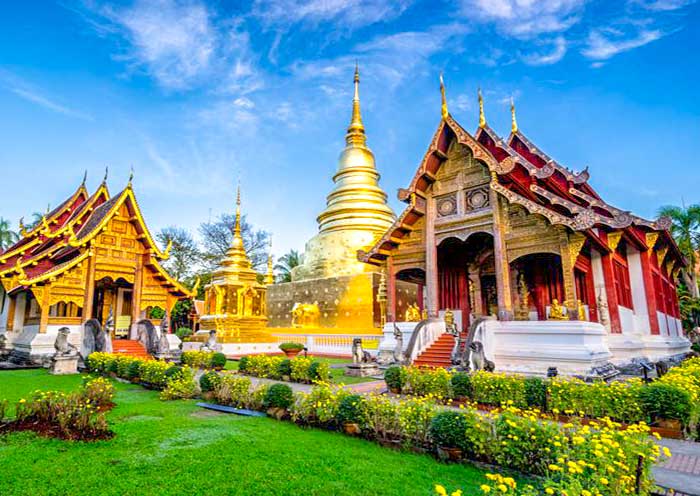

Chiang Mai is a popular destination to see elephants up close in a wide open space. Today, you will enjoy a half-day morning visit to Elephant Jungle Sanctuary. Afterward, you can freely relax for the rest of the day, perhaps by taking a Chiang Mai Cooking Class (15:30-19:00; optional) or trying out Lila Thai Massage near the Tha Pae Gate (optional). This offers a delightful opportunity to experience the real local life in Chiang Mai.
Upon arrival at the Elephant Jungle Sanctuary, savor a welcome snack while sipping tea or coffee and learning about elephants during an informative introduction. Get involved in the preparation of natural dietary supplements for the elephants before meeting these gentle giants. Feed them, administer supplements, and hear their inspiring stories while capturing memorable photos in their natural environment. Experience a unique mud spa session with the elephants, followed by a refreshing swim and shower in the specially constructed outdoor "Elephant Shower". You may even have the chance to engage in a fascinating "DIY Poop Paper" recycled paper activity.
After learning about the elephants, observe the elephants, feed the elephants, shower the elephants, enjoy a delicious lunch of traditional Thai cuisine and seasonal fruit, head back to your hotel, and enjoy your relaxing day freely. Overnight in Chiang Mai.
Warm Tips:
1.Book in advance: Elephant sanctuaries are popular attractions, so it's important to book your visit in advance, especially during peak season.
2.Wear appropriate clothing: You'll likely be doing some walking and getting muddy, so wear comfortable shoes and clothes that you don't mind getting dirty.
3.Respect the elephants: Always follow the instructions of your guide and be gentle and respectful when interacting with the elephants.
Free Time Idea around Chiang Mai Old City:
1.Half-day Thai Cooking Class in Chiang Mai: There are many Chiang Mai Cooking Schools that offer various Cooking Classes (appetizer, stir-fry, dish, soup, curry, dessert), from farm to table or from market to table, enjoy the famous Thai Dishes cooked by yourself (Thai tea, Tom Yam Soup, Pad Thai and more).
2.Try Chiang Mai Women's Correctional Institution Lila Thai Massage (Optional, self-pay). It is located near the Tha Pae Gate.
3.Foodie Experiences in Chiang Mai: Explore local markets around the Chiang Mai Ancient City such as Warorot Market (Everyday: 4am-6pm), Jing Jai Market (Everyday: 8:30am-9pm), Coconut Market (Saturday/Sunday/Monday, 8am-2pm), White Marke (Nimmanhaemin Road; 3pm-10pm; Closed on Weds & Thur.). Do double-check with your local guide for the market opening time.

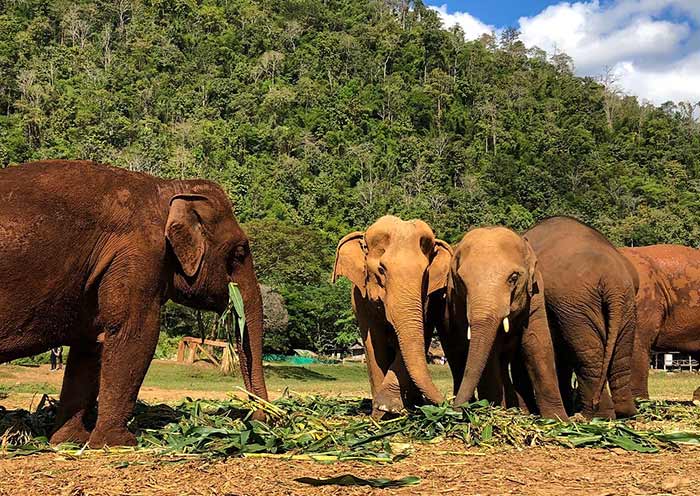


This morning,you will have some free time in Chiang Mai and explore more on your own till your guide or driver escorts you to the airport for your flight to Phuket. Overnight in Phuket, the largest and most beautiful island of Thailand. Leisure time by the beach in your hotel of Phuket. You can choose your hotel in Phuket near Patong Beach, Kata Beach, Karon Beach, or other beach you like.
This afternoon, you can choose to do a Half-day Foodie tour to Phuket Old Town (Optional).
Phuket Old Town is a vibrant and historic district in Phuket. It's known for its well-preserved Sino-Portuguese architecture, colorful shophouses, delicious street food scene, and various cultural attractions.
Phuket Old Town is Foodie Paradise, offering a wide range of delicious Thai and Chinese cuisine. You can explore Phuket dishes such as Dim Sum, fresh spring rolls, satay skewers, Roti Canai, Khao Tom, and Moo Hong (Red Pork), as well as Tropical Fruits (juicy mangosteen, refreshing dragonfruit, or the unique sweetness of durian). You can also find numerous local restaurants serving regional specialties and fresh seafood dishes. You might try flavorful curries like Massaman or Panang, fragrant stir-fries, or delicious noodle dishes like Pad Thai or Khao Soi.
Phuket Old Town boasts a rich history dating back centuries. It thrived as a trading port due to its tin mining industry, and the architectural style reflects the influence of Chinese and Portuguese settlers. Exploring the streets is like stepping back in time and experiencing Phuket's fascinating past. The well-preserved Sino-Portuguese shophouses with their vibrant colors, intricate details, and ornate balconies are a visual treat. You can discover hidden alleyways, charming cafes tucked away in courtyards, and unique shops selling local crafts and souvenirs.
Warm Tips:
1.Come Hungry: With all the delicious food you'll be sampling, it's best to come with an empty stomach to enjoy the experience fully.
2.Dress Comfortably: Walking tours involve exploring the streets, so wear comfortable shoes and clothes suitable for the warm Phuket weather.
3.Cash is King: While some vendors might accept cards, carrying cash ensures you can try everything that tempts your taste buds.
4.Dietary Restrictions: If you have any dietary restrictions, inform the tour operator beforehand to ensure they can accommodate your needs.
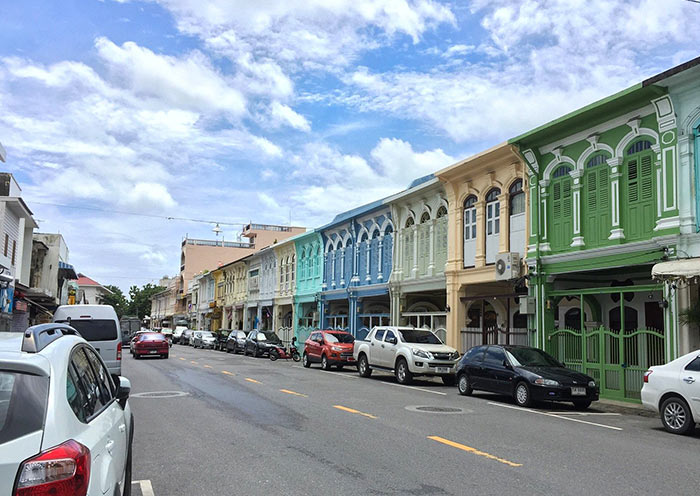
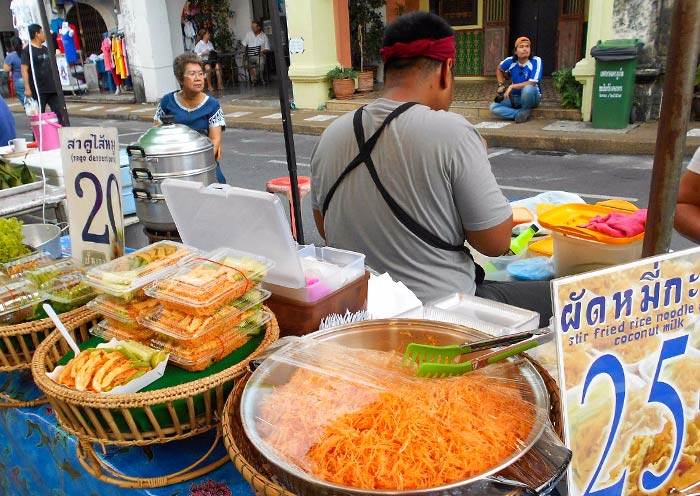
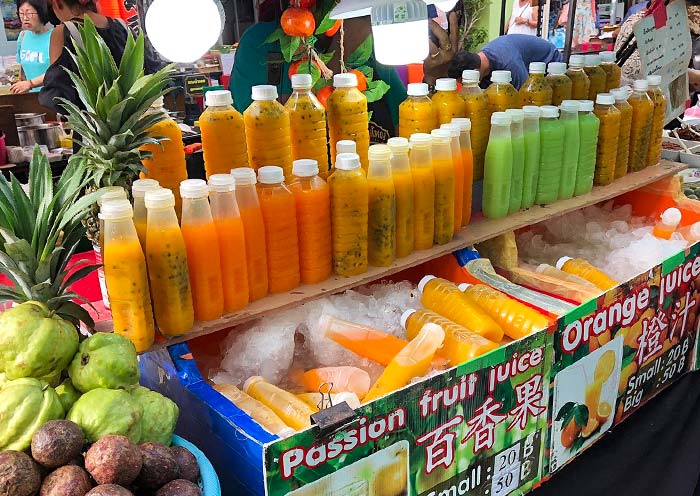

Leisure time by the beach in your hotel of Phuket. You can choose the hotel near Patong Beach, Kata Beach, Karon Beach, or other beach you like, to enjoy your relaxing days.
For the Party Gor, you can choose Patong Beach for water sports, exploring nightlife, shopping sprees, and day trips to nearby islands. You would love the energetic atmosphere, vibrant nightlife on Bangla Road, diverse restaurants and bars, and a wide range of shopping options including malls and markets. However, it can get crowded, especially during peak season.
For the Family Getaway, you can choose Kata Beach for water sports such as kayaking and paddle boarding, exploring viewpoints, visiting Kata Night Market for a local experience, taking cooking classes, and going on day trips to islands. You would love the calm waters and shallow areas, which are perfect for families with young children (specifically Kata Noi), the good selection of resorts and hotels, and the lively yet manageable nightlife at Kata Yai. However, it may be slightly more expensive than Karon Beach.
For the Relaxation Seeker, you can choose Karon Beach to relax on the beach, explore the underwater world, try surfing during the low season, take cooking classes, visit nearby temples like Wat Chalong, indulge in spa treatments, and explore Karon Night Market. You would love the laid-back atmosphere, spacious beach with soft sand, excellent snorkeling and diving at the southern end, a variety of water sports, and family-friendly activities like Dino Park Mini Golf. However, the nightlife options are limited compared to Patong, and it may not be the most luxurious choice.
Free Time Ideas:
1. For Island Hopping Adventures: Phuket is a great jumping-off point for exploring other stunning islands in the region. You can take a day trip to the Phi Phi Islands (optional, Phuket - Phi Phi Island - Phuket), famous for the movie "The Beach," or a day trip to the James Bond Island (optional, Phuket - 007 Island - Phuket)
2. You can choose to enjoy a half-day Phuket Elephant Sanctuary Tour (optional) if you are an Elephant fan.
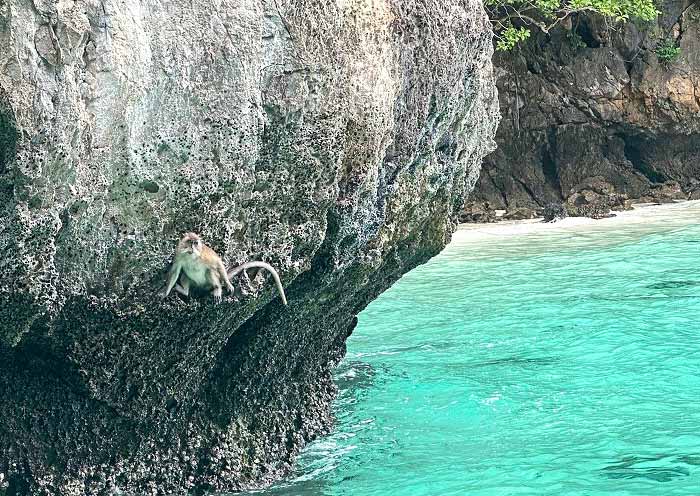
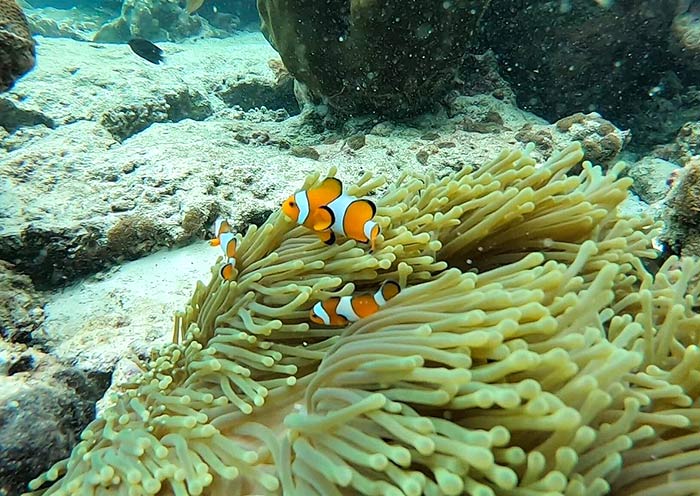
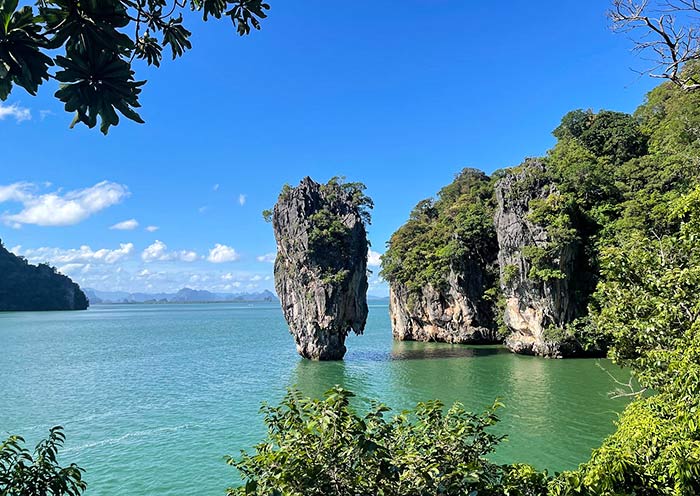

It is time to end your 12 Days Cambodia Thailand Tour. You will have some free time in Phuket and explore more on your own till your guide or driver escorts you to the airport for your flight to your next destination.
Trip Extension: If you prefer to travel longer in Southeast Asia you can extend your trip to neighboring countries such as Vietnam, Laos, etc.
Thank you for choosing Asia Odyssey Travel for your Asia tour, we are always here working for you and hope to see you again for your next trip to Asia. Safe journey!


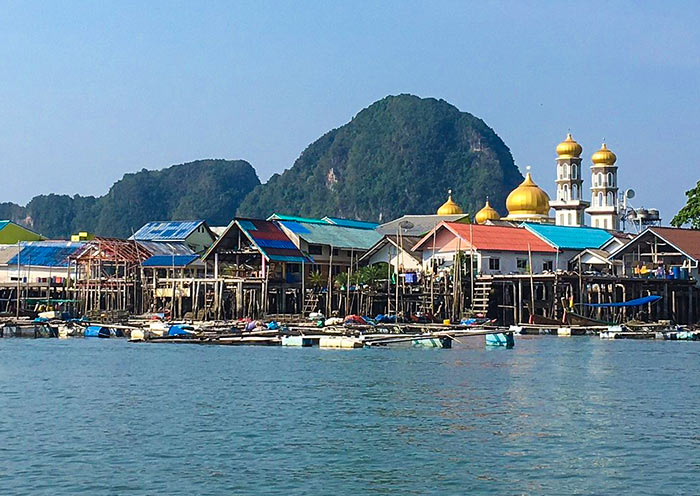

Price: What’s Included & What’s Excluded
What's Included:
What's Excluded:
Important Travel Tips for Visiting Southeast Asia
Visa requirements vary depending on your nationality and the length of your stay. It's important to check the specific requirements for each country you plan to visit well in advance of your trip. You can usually find this information on the embassy or consulate website of the country you're visiting.
Dry season (November to April): This is the peak tourist season for Southeast Asia as a whole, with the most consistent sunshine and comfortable temperatures. Ideal for beach lovers and those who want to avoid the rain. This is also a great time for trekking and other outdoor activities.
Average temperatures during Dry Season in Southeast Asia:
- Vietnam: 77°F - 86°F (25°C - 30°C): It can be slightly cooler in the northern mountains during December and January.
- Thailand: 82°F - 90°F (28°C - 32°C): Eastern and southern Thailand, including popular beach destinations, tend to be a few degrees warmer than the north.
- Laos: 75°F - 88°F (24°C - 31°C): Keep in mind that the mountainous areas of Laos can get chilly at night, especially in December and January.
- Cambodia: 84°F - 93°F (29°C - 34°C): Temperatures can get quite hot, especially from March to May, in Siem Reap (Angkor Wat).
The currency varies from country to country. In Vietnam, the currency is the Vietnamese đồng (VND). In Thailand, it's the Thai baht (THB). In Laos, it's the Lao kip (LAK). And in Cambodia, it's the Cambodian riel (KHR). However, US dollars are widely accepted in most tourist areas.
- Dress modestly: When visiting temples, pagodas, or other religious sites, it's important to dress modestly and respectfully. This means covering your shoulders and knees.
- Removing shoes: In many temples, it is customary to remove your shoes before entering. Look for a pile of shoes at the entrance as a cue to do the same.
- Bargaining: Bargaining is a common practice in Southeast Asia countries’ markets and street stalls. However, it's important to do so respectfully and with a friendly attitude. Remember that the aim is to reach a mutually agreed-upon price, not to aggressively drive the price down.
Looking for more travel guides about Southeast Asia countries? Want to gather additional information to plan your trip? Our team of professional travel experts has written over 100 articles about Vietnam Thailand Cambodia Laos. Please check out our Southeast Asia Travel Guide for inspiration and detailed insights.
Hotel Conditions for Your Southeast Asia Tour
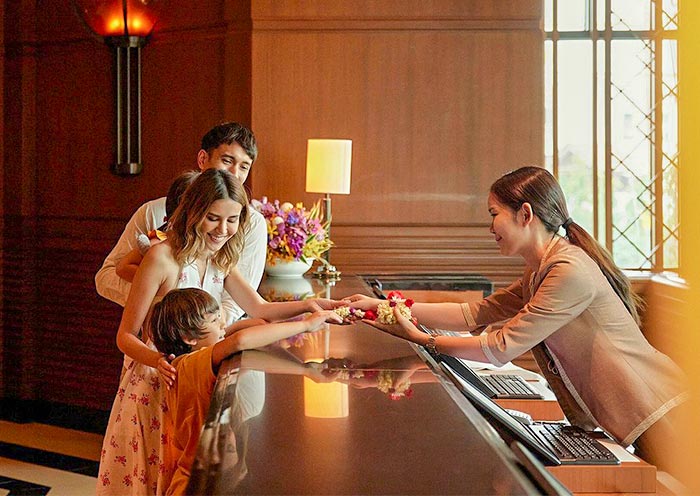

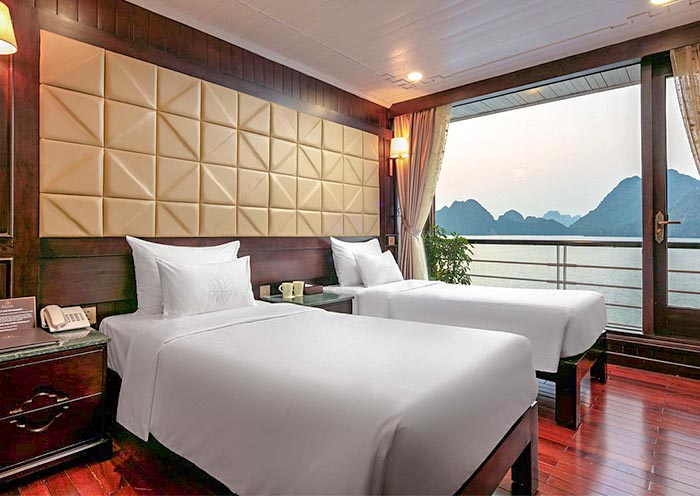
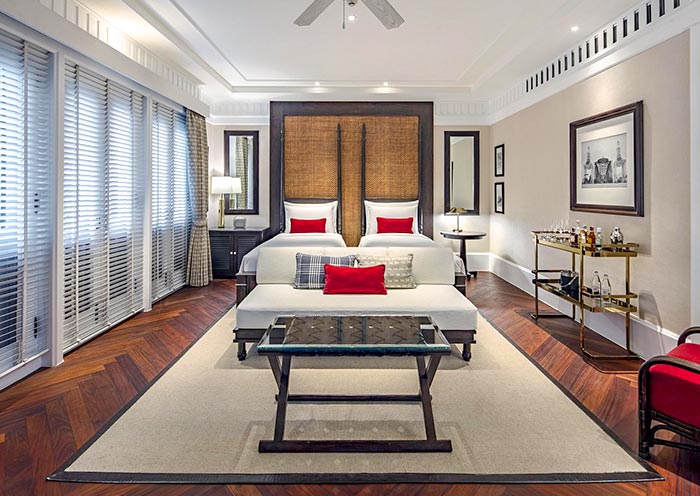
No matter whether you combine 2 or 3 countries, or visit all 4 countries in Southeast Asia, there are many different hotel styles and types to choose from. Travelers typically spend 7-9 nights in Vietnam, 6-9 nights in Thailand, and 2-3 nights each in Cambodia and Laos.
To cater to diverse traveler preferences and budgets, we offer a curated selection of accommodations. Our options include luxurious 5-star hotels, comfortable 4-star options, and economical 3-star establishments. All our selected hotels are conveniently located near city centers or popular tourist spots.
Find your perfect hotel for a great Southeast Asian experience! Our knowledgeable travel experts can provide you with various pricing options based on different hotels. Whether you seek a luxurious stay or have specific preferences, our experts will assist you in choosing the best option that suits your needs.
Photo Gallery for This Itinerary
Latest Southeast Asia Tours Reviews from Our Customers

Jan Woolley
USA
Date of Experience: Apr 26, 2024
Tour Customized by: Tony
You May be Interested in This Tour: Customized Tour

Emma
Singapore
Destination(s): Other
Date of Experience: Sep 14, 2023
Tour Customized by: Owen
You May be Interested in This Tour: Customized Tour

Arizona
Australia
Destination(s): Other
Date of Experience: Sep 04, 2023
Tour Customized by: Teresa
You May be Interested in This Tour: Customized Tour
Price: Request
(Based on a private tour for two people. Price varies depending on program, travel date, number of people.)
Free Enquiry! You don’t need to pay for the reservation.
- United States (+1)
- Australia (+61)
- Singapore (+65)
- Malaysia (+60)
- Philippines (+63)
- Canada (+1)
- Italy (+39)
- Indonesia (+62)
- United Kingdom (+44)
- Spain (+34)
- Mexico (+52)
- Hong Kong (+852)
- Thailand (+66)
- United Arab Emirates (+971)
- New Zealand (+64)
- South Africa (+27)
- Germany (+49)
- Brazil (+55)
- India (+91)
- France (+33)
- Vietnam (+84)
- The Netherlands (+31)
- Saudi Arabia (+966)
- Ireland (+353)
- Argentina (+54)
- Switzerland (+41)
- Romania (+40)
- Pakistan (+92)
- Japan (+81)
- Portugal (+351)
- Bangladesh (+880)
- South Korea (+82)
- Puerto Rico (+1)
- Türkiye (+90)
- China (+86)
- Belgium (+32)
- Qatar (+974)
- Greece (+30)
- Taiwan (+886)
- Austria (+43)
- Poland (+48)
- Israel (+972)
- Chile (+56)
- Sri Lanka (+94)
- Nigeria (+234)
- Peru (+51)
- Colombia (+57)
- Hungary (+36)
- Nepal (+977)
- Denmark (+45)
- Bulgaria (+359)
- Norway (+47)
- Slovenia (+383)
- Sweden (+46)
- Kuwait (+965)
- Costa Rica (+506)
- Ecuador (+593)
- Venezuela (+58)
- Malta (+356)
- Croatia (+385)
- Tunisia (+216)
- Czechia (+420)
- Mongolia (+976)
- Bahrain (+973)
- Mauritius (+230)
- Papua New Guinea (+675)
- Cambodia (+855)
- Dominican Republic (+1)
- Luxembourg (+352)
- Finland (+358)
- Guatemala (+502)
- Myanmar (+95)
- Maldives (+960)
- Slovakia (+421)
- Laos (+856)
- Serbia (+381)
- Brunei (+673)
- Oman (+968)
- Macao (+853)
- Panama (+507)
- Morocco (+212)
- Jordan (+962)
- Georgia (+995)
- Fiji (+679)
- Bolivia (+591)
- Lithuania (+370)
- Bahamas (+1)
- Cyprus (+357)
- Latvia (+371)
- Bhutan (+975)
- Iraq (+964)
- Iran (+98)
- Kenya (+254)
- Jamaica (+1)
- Zimbabwe (+263)
- Azerbaijan (+994)
- Uruguay (+598)
- Estonia (+372)
- Andorra (+376)
- Cameroon (+237)
- Ghana (+233)
- Kazakhstan (+7)
- Nicaragua (+505)
- Egypt (+20)
- Russia (+7)
- Albania (+355)
- Réunion (+262)
- Montenegro (+382)
- Algeria (+213)
- Afghanistan (+93)
- Martinique (+596)
- Uganda (+256)
- Honduras (+504)
- North Macedonia (+389)
- Trinidad and Tobago (+1)
- Suriname (+597)
- Antigua and Barbuda (+1)
- Zambia (+260)
- Ukraine (+380)
- Armenia (+374)
- Barbados (+1)
- Belarus (+375)
- Palestine (+970)
- Lesotho (+266)
- Moldova (+373)
- Ethiopia (+251)
- French Polynesia (+689)
- Gambia (+220)
- Guam (+1)
- Gibraltar (+350)
- Isle of Man (+44)
- New Caledonia (+687)
- El Salvador (+503)
- Comoros (+269)
- Seychelles (+248)
- Chad (+235)
- Samoa (+685)
- Cook Islands (+682)
- Palau (+680)
- Paraguay (+595)
- DR Congo (+243)
- Solomon Islands (+677)


